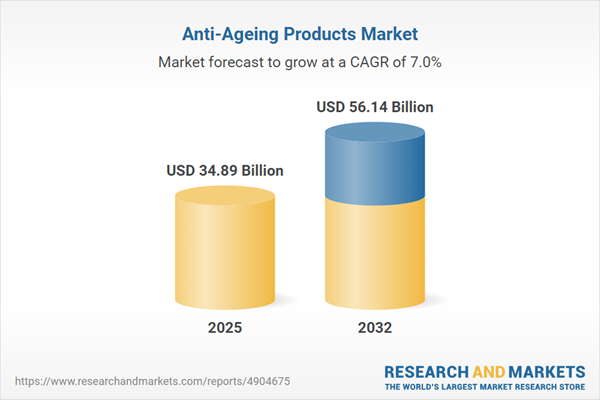Speak directly to the analyst to clarify any post sales queries you may have.
The anti-ageing products market is rapidly evolving as companies confront shifting global dynamics, technological innovation, and increasingly complex consumer priorities. Senior decision-makers must balance flexibility, regulatory compliance, and operational excellence to sustain growth and capitalize on new opportunities.
Market Snapshot: Key Trends in the Anti-Ageing Products Market
In 2024, the anti-ageing products market reached USD 32.59 billion. Projections indicate steady growth to USD 34.89 billion in 2025, with a forecasted market value of USD 56.14 billion by 2032, equivalent to a 7.03% CAGR. Key growth factors include heightened demand for advanced skincare solutions, increasingly rapid product refresh cycles, and the adoption of analytics to enhance market targeting. Driven by both established players and new entrants, digital transformation and operational agility have become critical, allowing brands to adjust targeting, compliance, and differentiation strategies for diverse consumer segments and to address both local and global challenges.
Scope & Segmentation: Anti-Ageing Products Market
- Product Types: Includes creams, lotions, serums, masks, injectable solutions, and dietary supplements. These offerings support a variety of consumer needs, encompassing both daily care and targeted intervention.
- Active Ingredients: Major actives such as collagen, hyaluronic acid, peptides, retinol, and vitamin C form the backbone of product efficacy. Transparency in ingredient sourcing and stewardship are increasingly valued across the value chain.
- Age Groups: Products are customized for specific life stages, enabling organizations to engage diverse consumer profiles with lifecycle marketing approaches and ensure continued relevance.
- Distribution Channels: Strategies utilize pharmacies, department stores, and online platforms to reinforce omnichannel experiences. Aligning channel strategy with evolving buyer preferences maximizes reach and customer satisfaction.
- User Demography: Brands are focusing on both male and female consumers, with a growing emphasis on inclusivity and the identification of new demographic opportunities that support market expansion.
- Geographic Coverage: Customized activations target North America, South America, Europe, Asia-Pacific, and the Middle East and Africa. Localized offerings ensure regional compliance and responsiveness to unique consumer expectations.
- Company Coverage: Leading organizations—including L'Oréal S.A., Estée Lauder, Procter & Gamble, Unilever, Johnson & Johnson, Shiseido, Beiersdorf, Amorepacific, Coty, and Natura & Co—invest in digital development, resilient supply chains, and strategic alliances to sustain competitiveness at regional and global levels.
Key Takeaways for Strategic Decision-Makers
- Ethical sourcing and transparent supply practices are essential to build lasting credibility across all anti-ageing sector partnerships and brands.
- Integrating biotechnology and digital data analytics sharpens market segmentation and enhances the development of tailored product offerings for emerging consumer niches.
- Continuous improvement of compliance and clean-label strategies positions organizations to meet changing regulations and enhance sustainability initiatives.
- Pursuing digital-first business models enables quick adjustment to changing global demand, supporting strategic market entry and expansion.
- Resilient, collaborative supply chains mitigate disruption risk and foster operational stability, both locally and globally, as regulatory landscapes shift.
- Routine compliance assessments help leaders anticipate evolving requirements, maintaining a proactive competitive stance in dynamic markets.
Impact of 2025 United States Tariffs on Supply Chains
Planned tariffs in the United States set for 2025 are increasing raw material costs, which heightens supplier risk for anti-ageing product manufacturers. In response, companies are diversifying suppliers and pursuing vertically integrated procurement to stabilize pricing and decrease susceptibility to trade volatility. These strategies help maintain a strong competitive position during periods of regulatory and policy change.
Methodology & Data Sources
This research relies on comprehensive secondary data from reputable industry publications, regulatory resources, and company records. Insights from scientific and supply chain experts inform both SWOT and PESTLE analyses, ensuring a robust assessment that equips senior leaders with actionable market intelligence.
Why This Report Matters
- Empowers senior leaders to deploy targeted risk controls, monitor compliance, and direct investments where they align with real-time market needs.
- Links innovation management and regulatory governance to value chain improvements for long-term sector strength.
- Facilitates proactive adaptation to regulatory shifts and helps organizations support resilience across changing marketplace dynamics.
Conclusion
Sustained growth in the anti-ageing products market relies on agile leadership and vigilance in trend monitoring. Adapting to evolving regulatory and consumer demands enables organizations to secure their commercial success in a fast-changing landscape.
Additional Product Information:
- Purchase of this report includes 1 year online access with quarterly updates.
- This report can be updated on request. Please contact our Customer Experience team using the Ask a Question widget on our website.
Table of Contents
3. Executive Summary
4. Market Overview
7. Cumulative Impact of Artificial Intelligence 2025
Companies Mentioned
The companies profiled in this Anti-Ageing Products market report include:- L'Oréal S.A.
- The Estée Lauder Companies, Inc.
- The Procter & Gamble Company
- Unilever PLC
- Johnson & Johnson Services, Inc.
- Shiseido Company, Limited
- Beiersdorf Aktiengesellschaft
- Amorepacific Corporation
- Coty Inc.
- Natura & Co Holding S.A.
Table Information
| Report Attribute | Details |
|---|---|
| No. of Pages | 194 |
| Published | October 2025 |
| Forecast Period | 2025 - 2032 |
| Estimated Market Value ( USD | $ 34.89 Billion |
| Forecasted Market Value ( USD | $ 56.14 Billion |
| Compound Annual Growth Rate | 7.0% |
| Regions Covered | Global |
| No. of Companies Mentioned | 11 |









